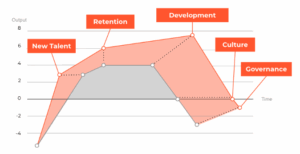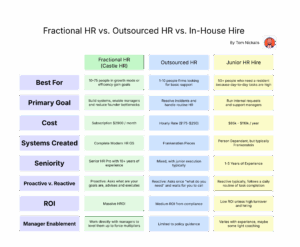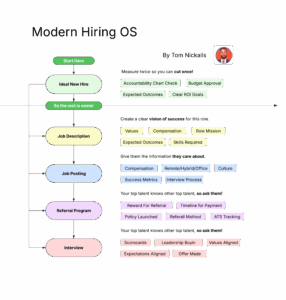Who this is for.
If you’re past the basement days…
Past ideation
Past “does anyone want this?”
You’re now in what HBR would refer to as Stage 3 “Success” in their article The Five Stages of Small Business Growth.
Stage 3 is where the product works, clients pay, and what is next now depends on you…
Because there are two stage 3s – Grow and Disengage.
At Stage 3 you have Product-Market Fit and have the opportunity to see revenue climb, cycles shorten, margins thicken, and your calendar finally belongs to you again.
To do that, we are talking about evolving to reach Stage 4.
At Stage 3, the difference between each isn’t another feature or a new policy; it’s a high-performance team.
To be clear, there is nothing wrong with being in Success – Disengage; you have a solid business and are making money. Life is good.
What we are going to explore is how to make your business more efficient and build a team that does the work to get you to Stage 4.
This article is a clear, practical look at the three options companies like yours face in Success Grow, and your choice will determine if you make it to Stage 4.
- Fractional HR (Castle HR): installs systems, enables managers, compounds results.
- Outsourced HR (Call Centre Style): clears queues, keeps you compliant.
- In-house HR (Junior/Generalist): provides daily presence and cultural proximity.
We’ll show how each one affects the Employee Lifetime Value (ELTV), which is what determines if you have a high-performing team.
What we’re actually trying to move: ELTV
Moving from Stage 3 to Stage 4 is about building a high-performance team.
But what does a high-performance team look like?
How do you know if you already have one?
Enter the Employee Lifetime Value chart…

Most leaders have not seen an ELTV chart before.
When I first saw this chart, my brain lit up like a Christmas tree…
Because the ELTV shows us the exact data points we must influence to make a high-performance team.
These data points helped Castle HR define its 5 pillars to our Modern HR OS:
- New Talent Acquisition: who you let in and how quickly they ramp.
- Top Talent Retention: keep your top performers, exit others promptly.
- Talent Development: investing in your team to level up performance.
- Culture: defining winning behaviours that everyone demonstrates.
- Governance: compliance and systems that translate into results.
If we do this right, then everyone on your team adds more value than average, and that makes a high-performance team!
The rest of this article discusses moving those five points on the ELTV and how each HR option at Stage 3 works.

The three operating models (and what it really feels like)
Fractional HR sells impact
A senior HR pro steps into your leadership rhythm and takes the HR hat off your head.
They learn your mission, decode your goals, and build a custom HR strategy that pulls every lever to hit your 12-month target.
You invest 1 hour a week in a working session that is actually valuable: decisions are made in the room, and execution happens between meetings without you.
The rest of the week? Back to you.
A live scoreboard keeps everyone honest.
Managers get the tools and coaching to run high-performance teams, and when manager quality rises, everything downstream improves (win rate, throughput, retention).
Week by week, your Modern HR OS is installed, and ELTV starts to swell: better hires in, faster ramp, steadier performance, fewer handoff misses, longer top-performer tenure.
You feel it first (fewer escalations).
The team feels it next (more ownership).
The numbers follow (increased revenue, happier team, healthier margins).
That cadence and clarity are exactly what McKinsey links to superior long-term performance.
Plain English: You buy outcomes that compound, and you keep the playbooks.
Managers account for ~70% of the variance in engagement/performance. – Gallup
Outsourced HR sells hours
A responsive vendor sits on call.
You still wear the HR hat, but now you’ve got a reliable tool in the kit.
They learn your policies, take your to-do list, and move the paperwork.
You open tickets; forms come back crisp; policies update; benefits questions get answered.
Backlogs thin. Risk drops. Admin fog clears without adding headcount.
But the operating model doesn’t change.
No accountability chart gets redrawn.
No manager cadence appears.
No hiring funnel is rebuilt to find top talent.
On the ELTV shell, you mostly touch Governance (useful!), but results stay linear, not compounding.
You get back admin time and compliance certainty (genuinely valuable), yet the throttle on growth (manager quality, performance, ramp-up) sits where it was.
Plain English: Great for volume. Not a vehicle for velocity.

In-house HR (Junior/Generalist) sells proximity
A helpful HR co-ordinator joins the team and becomes the daily point of contact.
They learn your culture. The office feels supported. Rituals run on time.
They take part of the HR hat, but you still set standards, review grey areas, and set tasks.
Requests move faster inside the walls; onboarding checklists are tidy; small frictions disappear.
Proximity, however, has a ceiling without senior design.
No manager playbook? Performance talks boomerang back to you.
No structured interviews? Hiring quality becomes hit-or-miss.
No owned workflows? Handoffs depend on hustle, not system.
The move that unlocks leverage: pair proximity with impact.
Give your junior clear templates and a fractional lead who supplies the plan, trains managers, and quality-assures the hard calls.
That’s how proximity turns into progress, and your time stops leaking back into HR.
Plain English: Inside help that feels great and scales when a senior partner points it at outcomes.
Pillar-by-pillar: how each model moves (or doesn’t move)
1) Talent Acquisition → Hiring Quality
CEOs don’t lose quarters because “no one applied.”
They lose them because the wrong people got in.
Hiring quality sets the entire ELTV shell: better inputs, better company.
Fractional (sells impact).
Your job posts stop sounding like committees and start speaking to A-players (salary upfront, outcomes clear, values stated).
Interviews move from “vibes” to structured scorecards; hiring managers learn to assess trajectory and impact rather than tenure and talk.
The interview cycle gets shorter without losing rigour because everyone knows what “great” looks like before candidates show up.
The result: quality over quantity with fewer interviews, better shortlists, faster yes/no decisions, and a new hire whom you feel lucky to add to your team.
Hiring stops being a time sink and starts being a growth lever.

Outsourced (sells hours).
The admin fog clears.
Postings go up quickly, forms are clean, background checks are completed on time, and candidates receive timely replies.
When your pain is hiring volume, this feels fantastic.
But the engine doesn’t change: the accountability for quality, the clarity of the success profile, and the discipline of structured interviewing still sit with you.
The queue moves; quality rarely does.
In-house (sells proximity).
There’s a helpful coordinator inside the walls.
Calendars are tidy, candidates feel looked after, and hiring managers aren’t chasing paperwork.
It feels better immediately.
Yet without senior standards, a clear success profile, scorecards, and interviewer training, quality becomes hit-or-miss.
Proximity becomes progress only when a senior lead supplies the playbooks and coaches the team through authentic assessments.
What a CEO should expect to see when hiring quality goes up:
Shortlists you’d gladly hire from, fewer interview rounds, offer-accepts without arm-twisting, and (most importantly) fast ramp-up and output you can point to.
That’s when the ELTV shell starts expanding, and the rest of the pillars get easier.
2) Culture (Values → Winning Behaviours)
Culture isn’t a poster; it’s “how we do things when the boss isn’t in the room.”
When values turn into winning behaviours, your ELTV starts widening in all directions.
Jim Collins, in his book Good to Great, calls folks that align with your winning behaviours the Right People.
Fractional (sells impact).
Start with stories, not slogans.
We sit with the founder and leaders, pull out the mission in plain language, and translate it into winning behaviours.
The “this is how we do things here” you can point at in a meeting.
Analogies, examples, and edge cases are spelled out so there’s no guesswork.
Values become hireable, coachable, and reviewable.
Managers are then taught to catch and coach those behaviours in performance reviews.
Feedback has clarity.
Jim Collins’ idea shows up in practice because you’ve defined the “right people,” so now you actually recruit and hold them accountable.
What you feel: better hires that faster ramp because standards are obvious and aligned.
Fewer do-overs because “good” isn’t fuzzy.
Leaders pulling in the same direction without you in the room.
How ELTV expands: quicker Ramp-Up, higher and steadier Peak Productivity, tighter
Longer tenure because people stay where the game feels fair, focused, and winnable.
Outsourced (sells hours).
You’ll get values, but they read like a generic poster.
The vendor is responsive and tidy, just not close enough to your context to make it personal and impactful.
Handbooks are cleaner. Risk is lower.
Behaviour on the floor? Mostly unchanged.
Managers aren’t trained to coach your values.
Interviews don’t screen for them with any rigour.
Reviews don’t consistently reward (or correct) them.
What you feel: safer paperwork, same habits.
How ELTV nudges: some consistency via documents, but little lift to ramp-up, performance, or tenure because values didn’t become behaviours.
In-House (sells proximity)
There’s heart and presence.
Town halls land. Rituals run on time. Comms feel warm.
Proximity makes belonging easier.
But crafting high-performance values is a senior craft.
Even if the words are right, embedding them takes a playbook: interview prompts that test behaviours, managers that coach them, reviews that reward them.
Without that spine, tough trade-offs snap the team back to old habits.
What you feel: momentum in moments; drift in the day-to-day unless you’re hands-on.
How ELTV moves: proximity lifts ramp-up and tenure slightly.
Bottom line for Culture → ELTV
Personalized values plus manager coaching = behaviour you can measure.
That’s the difference between a wall poster and a performance system and it’s why fractional keeps people longer, ramps them faster, and raises the peak you can sustain.
3) Talent Development → Peak Productivity
High performance isn’t “try harder.”
It’s teach better, coach tighter, measure what matters, then do it every quarter.
Fractional (sells impact)
Your managers stop being traffic cops and start being force multipliers.
We install a manager playbook: quarterly conversations with outcomes, live coaching on feedback, role clarity that fits the real work, and growth paths that reward impact over tenure.
Scoreboards shift from “activity” to throughput and quality.
In services, utilization rises without burnout; in software, cycle time drops, and fewer tickets come back for rework.
Promotions come from the bench you built.
What you see: fewer escalations, tighter execution, and teams that ship without you.
How ELTV expands: a higher performance peak and longer tenure because top talent can see precisely how to win here.
Outsourced (sells hours)
You get tidy templates, a few generic trainings, and an LMS module on feedback.
Helpful infrastructure you could find on Google.
But no one is in the room turning a messy convo into a coachable moment, or rewiring a team’s rituals so work moves faster next week than it did this week.
What you feel: admin relief; same performance curve.
ELTV performance budges up, but nowhere near the peak.
In-house (sells proximity)
Your co-ordinator can schedule sessions, wrangle attendance, and keep the calendar honest.
They’ll even surface who needs help sooner.
But designing a manager system (the cadence, the language, the standards, the scorecard) is senior craft.
So you will likely have a template performance, which leads to minimal impact.
They also aren’t able to coach and challenge your managers to coach and challenge their team.
So the ELTV slightly lifts across performance and tenure, but you get motion, not momentum.
CEO lens: Peak Productivity climbs when managers become a product you invest in.
Raise that layer, and everything downstream (speed, quality, retention) starts compounding.
That’s the difference between hoping people “step up” and installing a proven system where they can’t help but win.
4) Governance (Ops & Compliance) → Consistency / Throughput
Governance is the rails your team runs on.
It’s your HRIS as the source of truth, a living accountability chart, and a complete documentation stack: handbook, contracts, health & safety, legally required policies, hiring and termination practices, plus on-demand advice when the spicy meatballs show up.
When this is tight, you save time, you stay compliant, and you stop getting sued for preventable mistakes.
That’s the job.
Fractional (sells impact)
Your HRIS is the single source of truth, not a filing cabinet.
The accountability chart reflects the company you are now (and where you’ll be in 1/2/5 years).
Your policy stack is custom to your risk profile and actually used: handbook, contracts, H&S, required postings, and clear termination playbooks.
Approvals and requests run on automated workflows (offers, promotions, PTO, onboarding, exits).
Managers gain a decision/escalation guide, so “Can I…?” pings drop.
When the tough stuff hits (terminations, investigations), you have your senior HR pro on demand to provide advice that keeps risk low and time required low.
What you feel: fewer interrupts, faster request → approval → done, clean audits, and confidence that exits won’t explode.
What moves on ELTV: faster ramp-up because people can follow the rails on day one.
Longer tenure because the game feels fair and professional.
Shorter costs when someone exits because your documentation and advice are sound.
Outsourced (sells hours)
You’ll get policies and forms fast.
Contracts reviewed. Health & safety updated.
Good, clear advice on routine and not-so-routine questions.
Admin fog lifts, and your risk profile improves.
But the operating model doesn’t change: the HRIS often stays a repository, approvals still boomerang to you, and handoffs still rely on good intentions rather than design.
What you feel: less paperwork, fewer compliance worries and speed across teams largely unchanged.
ELTV shifts mainly on the compliance exit side, not on ramp-up or throughput.
In-house (sells proximity)
Your co-ordinator keeps the HRIS tidy, tracks signatures, schedules H&S, and answers questions quickly.
Culture feels supported, and people know where to go.
Where it stalls is architecture: designing a real delegation map, automating approvals, writing investigation/termination playbooks, and handling “spicy” cases with low legal risk.
What you feel: better responsiveness, but you still step into the hard calls and spend significant time there.
ELTV nudges at the edges.
Governance isn’t paperwork; it’s time insurance.
Install a real HRIS, a true accountability chart, documented standards, and automation, and you’ll delegate to elevate for fewer surprises, no more weekend emergencies, and a company that moves faster and stays out of court.
5) Talent Retention → Tenure & Exit Quality
Retention isn’t “pizza Fridays.”
Top talent stay where the mission feels real, the team is strong, and the standards are clear.
That’s retention.
It’s cultural alignment plus a simple operating system that proves, every quarter, who’s the right person in the right seat—and who isn’t yet.
Fractional (sells impact)
We build the retention engine you can see working from the CEO seat.
Quarterly surveys surface truth; quarterly performance reviews create accountability.
Each review answers four things: values fit (right person), outcomes (right seat), growth path (career), and wellness (human to human).
Your performance review will live in your HRIS, so it’s a routine, not a scramble.
Managers get hands-on coaching: how to give specific feedback, how to coach up when there’s potential, and how to coach out when there isn’t.
New leaders learn by doing, with a senior HR pro in their corner every quarter to inspect quality and raise the bar.
What you actually see: regrettable turnover falls, referral flow rises, and your best people stay because they’re working with other best people.
ELTV expands because tenure extends, ramp-up isn’t constantly resetting, peak performance holds longer, and exits (when needed) are clean.
Outsourced (sells hours)
You’ll get templates for reviews and maybe a script for a tough conversation.
Helpful, fast, tidy.
But there’s no manager coaching, no cadence enforcement, and, if they exist, surveys aren’t turned into action.
Whether feedback lands now depends on first-time managers reading a script.
What you see: paperwork done; tenure not overly extended, and top talent still exits regrettably.
ELTV barely shifts because leaders didn’t level up.
In-house (sells proximity)
Your co-ordinator can load reviews into the HRIS, send reminders, and collect completions.
They’ll spin up surveys and tidy the follow-ups.
That creates accountability for completion, which is good.
Where it stalls is the craft: making the reviews bite on values and outcomes, interpreting surveys into priorities, and coaching managers through real growth or exit paths.
What you see: rhythm without results.
CEO lens: retention is the compounding lever.
Keep the right people longer, and everything else gets easier and cheaper.
Install the manager habits, recognition systems, and fair processes that make staying the obvious choice and ELTV climbs because the months you’re paying for produce more of what you actually want.
A short, adult conversation about cost
Employees aren’t just salaries.
If you’re thinking about a junior hire, budget 1.25–1.4× (SHRM) base for benefits, payroll taxes, tools, and training and then budget leadership time for coaching.
Outsourced HR usually means a lower monthly base with fees that follow ticket volume great for steady admin needs, but it will never redesign the machine.
Fractional HR is a variable retainer for impactful outcomes. Because the playbooks are proven and customized, you see value
As the flywheel runs, you dial spend down and keep the gains.
The cheapest option is the one that buys back CEO hours, shortens cycles, and moves at least one ELTV lever in the next 12 months.
Everything else is noise.
Conclusion: make next year math, not hope
If you’re in HBR’s Stage 3 (Success) with product-market fit achieved, revenue steady, leadership stretched, then you have a decision to make.
If you want to get to Stage 4: Take Off.
That jump doesn’t come from one more feature or a louder campaign.
It comes from expanding Employee Lifetime Value (ELTV): better people in, faster ramp, higher and steadier output, cleaner handoffs, longer tenure.
In plain terms, a high-performance team.
That’s what the right HR operating model unlocks:
- Fractional sells impact. A senior operator installs the Modern HR OS (Hiring OS, 30/60/90 onboarding, manager cadence, values → behaviours, real governance).
You feel it as time back, week-two output from new hires, shorter request→done cycles, and margins that stop leaking in the handoffs.
ELTV widens on every axis, which is precisely how you get to Stage 4.
- Outsourced sells hours. When the pain is volume, tickets get handled, risk stays low, and the queue moves.
Helpful and honest, but it won’t stretch the ELTV shell, so you stay in Stage 3: Disengagement.
- In-house (junior) sells proximity. Daily presence and warm comms matter.
Pair that proximity with a fractional spine and it becomes progress; without it, you’re still wearing part of the HR hat and ELTV gains stay small.
Again, you are likely to stay in Stage 3: Disengagement here.
Your choice is to pick the model that gets you to your goals.
Do you want to expand ELTV the fastest and level up to Stage 4?
Or are you happy with Stage 3 Disengagement (which again is completely fine and you will have a great life).
If you still have questions…
One simple next step
Book a 20-minute CEO diagnostic.
We’ll map your ELTV bottlenecks across the five pillars, show exactly where Fractional, Outsourced, or In-house will move the needle for you, and hand you a 12-month plan.

Tom Nickalls is the founder and CEO of Castle HR. Castle was launched in 2019 with the mission of helping businesses build high-performance teams by prioritizing culture, onboarding, and employee development. Since then, Castle has grown exponentially and empowered 100+ companies in Canada to scale smarter with modern, fractional HR service and strategy. Passionate about fostering strong workplace dynamics, Tom is dedicated to aligning business success with employee satisfaction in the ever-evolving world of work.